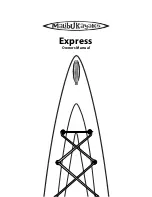
Sailing Upwind
It’s important to learn and really know your modes,
and the settings for them for each day’s conditions
or positioning around other boats. Develop good,
clear wording for the mode you want to be in, so the
Trimmers can make it happen. This is led by having
the Tactician or Helm describe what they are trying to
achieve. The Main Trimmer is the lead communication
point and will talk with the Trimmer as to how to set
up the boat for a certain mode. While I feel it’s best to
have the Trimmer call the breeze, sometimes it’s just
too much, so some teams may assign the next person
forward to be responsible for this.
The way I think is best to set up your crew to sail
upwind is to positioning the weight on the rail for
maximum righting moment. From the front 8) Bow,
6) Pit, 5) Trim #2, if Mast is tailing, 7) Mast, if they are
your strongest/biggest crew member, 4) Trimmer, 3)
Main, 1) Helm, then 2) Tactician and 9) Floater in the
back doing the runners. This positioning will change if
you set up your team differently or have the strength
and weight spread differently among the positions. I
would want all the weight concentrated around the
middle stanchion with Mast sitting right in front of
it, allowing the Trimmer to be behind the stanchion,
with more room to get in and out without being in the
way of the winch handle for the mainsheet. Once the
wind increases—likely over 12kts—move the heaviest
person aft to hike next to the aft stanchion.
Tacking
1. Helm
•
Execute smooth steering through the tack;
different conditions will require a different rate of
turn and amount of helm to get the boat onto the
new tack.
•
Land the boat on correct angle; focus on the boat
speed and heel angle for getting to target.
2. Tactician
•
Communicate style of tack.
•
Call countdown to tacking the boat.
•
Release old runner and load it again—or leave it
off the winch if a dip is expected or on final tack to
windward mark. Alternatively, bring on new runner
if Floater releases old.
3. Main
•
Trim main and adjust traveler depending on conditions.
•
Communicate about speed build with Helm and
Trimmer.
4. Trimmer
•
Release jib sheet and go to leeward and does
build/trim set up; trim on once at speed.
•
Or tail jib and do build/trim set up; trim on once at
speed
•
Call landing angle for speed build.
•
Talk about bottom speed and how well speed is
building.
5. Trim #2
•
Tail jib sheet in—unless Trimmer or Mast do this.
•
Or release jib sheet and go straight to rail.
•
Cross to new side with vang tail in hand if not
involved with the jib.
6. Pit
•
Cross to the new side.
7. Mast
•
Tail jib sheet in tack unless Trimmer or Trim #2
does this.
•
Otherwise, go to new side and hike, taking vang
tail with them
8
. Bow
•
Cross from side to side.
•
Clear halyard if needed, or get it ready for the hoist
on final tack into mark.
9. Floater
•
Bring on the new runner or release old runner
(see Tactician).
Содержание IC37
Страница 1: ...Sailing Manual 1 0...
Страница 2: ......
Страница 18: ...12 Knot Configuration Light Air Configuration...
Страница 19: ...Drifting Configuration...
Страница 20: ...northsails com...






































